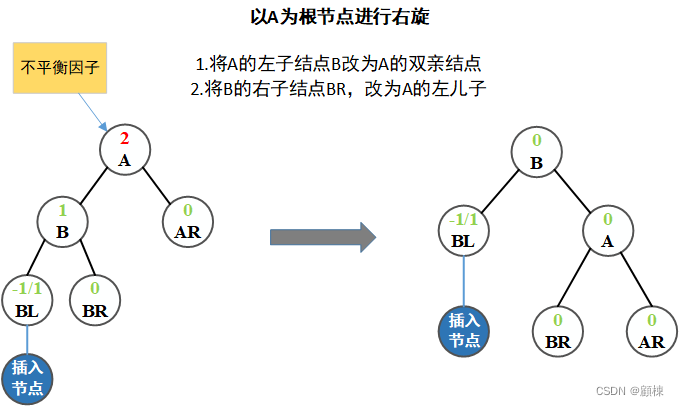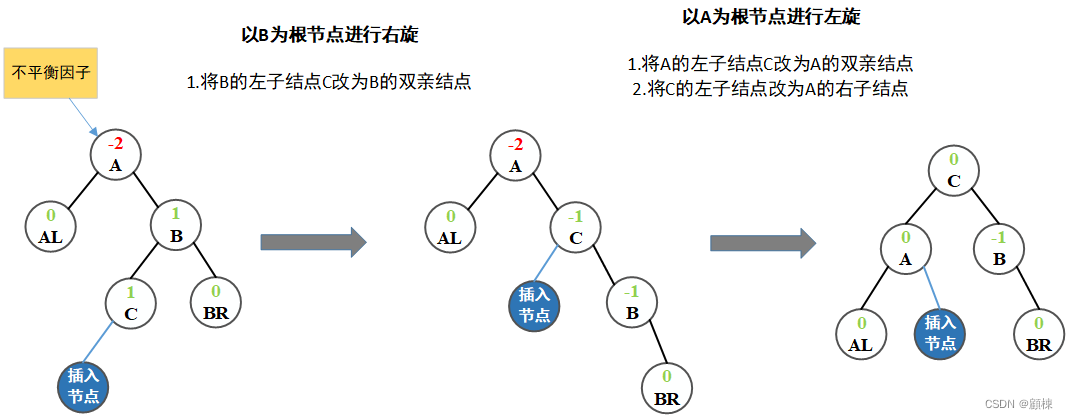- 平衡二叉树
- 定义
- 结点的平衡因子BF(balance factor)
- 查询,删除过程
- 检查平衡
- 平衡操作--左旋和右旋
- JAVA代码实现
亦称为AVL
空树和1个点节点的树都是平衡二叉树
平衡二叉树是在二叉排序树上的扩展延伸,除了自身的性质还满足以下性质的二叉树:
- 树中的子树都是平衡二叉树
- 每颗子树的左子树和右子树的深度之差的绝对值不超过1。
该结点的左子树的深度减去右子树的深度,则平衡二叉树上所有节点的平衡因子的值为-1,0,1。
查询,删除过程它的查询和删除系列操作思路跟二叉排序树差不多,可以阅读二叉排序树的JAVA实现
检查平衡通过计算每个结点的平衡因子来判断是否平衡。只要平衡因子为2 或 -2,就说明此结点子树不平衡。
平衡操作–左旋和右旋当平衡二叉树由于新增数据元素导致整棵树的平衡遭到破坏时,就需要根据实际情况做出适当的调整,寻找距离插入结点最近的“不平衡因子”。则调整的规律可归纳为以下 4 种情况:
-
单向右旋平衡处理:若由于结点A的左子树为根结点的左子树上插入结点,导致结点A的平衡因子由 1 增至 2,致使以A为根结点的子树失去平衡,则只需进行一次向右的顺时针旋转,如下图这种情况:

-
单向左旋平衡处理:如果由于结点A的右子树为根结点的右子树上插入结点,导致结点A的平衡因子由 -1变为 -2,则以A为根结点的子树需要进行一次向左的逆时针旋转,如下图这种情况:

-
双向旋转(先左后右)平衡处理:如果由于结点A的左子树为根结点的右子树上插入结点,导致结点A衡因子由 1 增至 2,致使以A为根结点的子树失去平衡,则需要进行两次旋转操作,先以A的左子结点B为根结点进行左旋,在以A为根结点进行右旋,如下图这种情况:

-
双向旋转(先右后左)平衡处理:如果由于结点 A 的右子树为根结点的左子树上插入结点,导致结点 A 平衡因子由 -1 变为 -2,致使以 a 为根结点的子树失去平衡,则需要进行两次旋转操作,先以A的左子结点B为根结点进行右旋,在以A为根结点进行左旋,如下图这种情况:

package tree.avl;
import org.apache.commons.lang.StringUtils;
import java.util.LinkedList;
import java.util.Queue;
/**
* @author Donny
* @date 2022/5/18
*/
public class AvlTree {
public static final StringBuilder VALUES = new StringBuilder();
public static final String SEPARATOR = "->";
public static final int SEPARATOR_LENGTH = SEPARATOR.length();
/**
* 右子树需要平衡操作
*/
private final int RIGHT = 0;
/**
* 左子树需要平衡操作
*/
private final int LEFT = 1;
/**
* 树根
*/
private AvlTreeNode root;
/**
* 树的结点类
*/
private static class AvlTreeNode {
/**
* 存储的数值
*/
private int data;
/**
* 左子结点
*/
private AvlTreeNode leftChild;
/**
* 右子结点
*/
private AvlTreeNode rightChild;
/**
* 双亲结点
*/
private AvlTreeNode parentNode;
public AvlTreeNode(int data) {
this(data, null, null, null);
}
public AvlTreeNode(int data, AvlTreeNode parentAvlTreeNode) {
this(data, null, null, parentAvlTreeNode);
}
public AvlTreeNode(int data, AvlTreeNode leftAvlTreeNode, AvlTreeNode rightAvlTreeNode, AvlTreeNode parentAvlTreeNode) {
this.data = data;
this.leftChild = leftAvlTreeNode;
this.rightChild = rightAvlTreeNode;
this.parentNode = parentAvlTreeNode;
}
/**
* 计算结点的高度
*/
public int height() {
return Math.max(leftChild == null ? 0 : leftChild.height(), rightChild == null ? 0 : rightChild.height()) + 1;
}
/**
* 左子树的高度
*/
public int leftHeight() {
if (leftChild == null) {
return 0;
} else {
return leftChild.height();
}
}
/**
* 右子树的高度
*/
public int rightHeight() {
if (rightChild == null) {
return 0;
} else {
return rightChild.height();
}
}
/**
* 计算平衡因子
*/
public int calcBalanceFactor() {
return leftHeight() - rightHeight();
}
}
/**
* 以node为根结点 左旋
*/
public AvlTreeNode leftRotation(AvlTreeNode node) {
if (node != null) {
// 将当前结点的双亲结点转移给当前结点的右子结点
AvlTreeNode rightChild = node.rightChild;
// 右子结点的左子结点作为当前结点的右结点
node.rightChild = rightChild.leftChild;
if (rightChild.leftChild != null) {
rightChild.leftChild.parentNode = node;
}
// 右子结点的双亲结点变为当前结点的双亲结点
rightChild.parentNode = node.parentNode;
// 判断当前结点的父结点是否存在
if (node.parentNode == null) {
this.root = rightChild;
}
/*
* 当前结点结点不是根结点 分两种情况
* 1、当前结点结点位于其父结点左边,则原左子结点也要位于左边
* 2、当前结点结点位于其父结点右边,则原左子结点也要位于右边
*/
else if (node.parentNode.rightChild == node) {
node.parentNode.rightChild = rightChild;
} else if (node.parentNode.leftChild == node) {
node.parentNode.leftChild = rightChild;
}
// 将右子结点的左子结点改为当前结点
rightChild.leftChild = node;
// 将原右子结点当前结点的双亲结点
node.parentNode = rightChild;
}
return null;
}
/**
* 以node为根结点 右旋
*/
public AvlTreeNode rightRotation(AvlTreeNode node) {
if (node != null) {
// 用变量存储node结点的左子结点
AvlTreeNode leftChild = node.leftChild;
// 将leftChild结点的右子结点赋值给node结点的左结点
node.leftChild = leftChild.rightChild;
// 如果leftChild的右结点存在,则需将该右结点的父结点指给node结点
if (leftChild.rightChild != null) {
leftChild.rightChild.parentNode = node;
}
// 将当前结点的双亲结点转移给当前结点的左子结点
leftChild.parentNode = node.parentNode;
if (node.parentNode == null) {
// 即表明node结点为根结点
this.root = leftChild;
}
/*
* 当前结点结点不是根结点 分两种情况
* 1、当前结点结点位于其父结点左边,则原左子结点也要位于左边
* 2、当前结点结点位于其父结点右边,则原左子结点也要位于右边
*/
else if (node.parentNode.rightChild == node) {
// 即node结点在它原父结点的右子树中
node.parentNode.rightChild = leftChild;
} else if (node.parentNode.leftChild == node) {
node.parentNode.leftChild = leftChild;
}
leftChild.rightChild = node;
node.parentNode = leftChild;
return leftChild;
}
return null;
}
/**
* 新增key
*/
public void insert(int key) {
// 若树根为null 则新建结点作为树根
if (null == root) {
root = new AvlTreeNode(key);
return;
}
// p作为遍历树结点的临时帮助结点
AvlTreeNode p = root;
// prev代表新增key的结点的双亲结点
AvlTreeNode prev = null;
while (null != p) {
prev = p;
if (key > p.data) {
p = p.rightChild;
} else if (key prev.data) {
// 新增结点是prev的右子结点
prev.rightChild = node;
} else {
// 新增结点是prev的左子结点
prev.leftChild = node;
}
rebuild(prev);
}
/**
* 计算结点的平衡因子进行平衡操作
* 平衡因子为-1,0,1是为平衡的,所有一旦平衡因子为2或-2就需要进行平衡操作。
*/
private void rebuild(AvlTreeNode p) {
while (p != null) {
if (p.calcBalanceFactor() == 2) {
// 说明左子树高,需要【右旋】或者【先左旋后右旋】
fixAfterInsertion(p, LEFT);
} else if (p.calcBalanceFactor() == -2) {
// 说明右子树高,需要【左旋】或者【先右旋后左旋】
fixAfterInsertion(p, RIGHT);
}
p = p.parentNode;
}
}
private void fixAfterInsertion(AvlTreeNode p, int type) {
// 左子树失衡
if (type == LEFT) {
final AvlTreeNode leftChild = p.leftChild;
// 左子结点不为空,直接右旋
if (leftChild.leftChild != null) {
//LL型
rightRotation(p);
} else if (leftChild.rightChild != null) {
// 先左旋后右旋 LR型
leftRotation(leftChild);
rightRotation(p);
}
} else {
// 右子树失衡
final AvlTreeNode rightChild = p.rightChild;
// 右子结点不为空,直接左旋
if (rightChild.rightChild != null) {
// 左旋 RR型
leftRotation(p);
} else if (rightChild.leftChild != null) {
// 先右旋,后左旋 RL型
rightRotation(p);
leftRotation(rightChild);
}
}
}
/**
* 中序输出
*/
public String inOrderPrint() {
return inOrderPrint(this.root);
}
/**
* 中序输出
*/
private String inOrderPrint(AvlTreeNode node) {
String result = "";
if (node != null) {
inOrderPrint(node.leftChild);
VALUES.append(node.data).append(SEPARATOR);
inOrderPrint(node.rightChild);
}
if (StringUtils.isNotBlank(VALUES.toString())) {
result = VALUES.substring(0, VALUES.toString().length() - SEPARATOR_LENGTH);
}
return result;
}
public void printLeft() {
if (this.root == null) {
return;
}
Queue queue = new LinkedList();
AvlTreeNode temp;
queue.add(root);
while (!queue.isEmpty()) {
temp = queue.poll();
System.out.print("结点值:" + temp.data + ",平衡值:" + temp.calcBalanceFactor() + "\n");
if (temp.leftChild != null) {
queue.add(temp.leftChild);
}
if (temp.rightChild != null) {
queue.add(temp.rightChild);
}
}
}
public AvlTreeNode getNode(int value) {
AvlTreeNode temp = root;
int t;
do {
t = temp.data - value;
if (t > 0) {
temp = temp.leftChild;
} else if (t
关注
打赏



